The term plankton was first coined by oceanographer Victor Hensen in 1887. The word plankton comes from the Greek word planktos which means to be driven or drifted away.
According to him, plankton is diverse collection of small organisms and the individual organism makes up the plankton, known as plankters. Onec a that time they were considered to be found in the sea water. Now they live in all the water bodies and move in water through the process of waves and other movements. Actually, they can not swim against a current due to very feeble locomotory organs.
Plankton (sing. Plankter) is a diverse group of organisms that live in water and cannot swim against the water current. They are used as an important food source for a variety of aquatic organisms such as fish and whales. They are floating organism such as various animals, protists, archaea, algae or bacteria etc. and they live in the pelagic region of the sea, ocean or freshwater. Although many plankton species are microscopic in size, they include a variety of organisms, including large organisms such as jellyfish.
Plankton usually move with the help of currents. However, some plankton can move freely. They can even swim hundreds of meters vertically in a day. This type of behavior is called dial vertical orientation. Their horizontal position is mainly determined by the currents. Nectons, on the other hand, such as squid, fish and marine mammals, can swim against strong currents and control their position in the aquatic environment.
Within plankton, holoplankton spend the entire life cycle as plankton, as do most algae, copypods, salps, and some jellyfish. Meroplankton, on the other hand, (sea urchins, starfish, crustaceans, marine insects, and most fish) spend part of their life cycle (usually in the larval stage) as plankton, and subsequently live alternately nectonic or benthic life. The abundance and spread of plankton depends on the concentration of nutrients, the physical condition of the water and the abundance of other plankton.
LaMotte 1063 Plankton Net
Planktonic organisms: Plankton vary widely in quality in different types of freshwater reservoirs. This type of plankton is found in large quantities in freshwater.
(A) Plants
(1) Algae: Plankton is representative of all classes of algae. However, some classes are widespread in inland water bodies.(2) Bacteria: A large number of bacteria are considered as plankton. It is assumed that bacteria are found in all the water bodies in the earth.
(B) Protista
All classes and subclasses of protozoa (except sporozoa) contain plankton. In most cases ,there are many genera and species.
(C) Animals
(1) Coelenterata: Hydra is an opportunistic plankton. Sometimes they can be seen freely in open water.(2) Rotatoria: These are the most important group of zooplankton.(3) Gastrotricha: Plankton contains a small number of gastrotrica representatives.(4) Bryozoa: They are considered as statoblast plankton. Moreover, larvae that sometimes swim freely in special conditions are also considered plankton.(5) Arthropoda: Crustacea: Antomostracha, especially Cladosera and Copypods, form more important plankton groups.Some insect larvae exist as common plankton in stagnant water.
Occassional Plankton
The above group of organisms exists in large numbers as plankton. There are some groups of creatures that behave like real plankton, either accidentally or under unusual circumstances. Organisms belonging to the following groups are considered plankton in special cases.
Flowering plants: The role of these plants in the formation of actual plankton is very small. Lemnaceae (Wolffia) have been found in several river depths, as an exceptional examples.
(2) Coelenterata: Lives as Medusa plankton of freshwater rhinoceros.
(3) Platyhelminthis: Turbellarians are of little importance as freshwater plankton. However, at certain times of the year, they are found in abundance in damp ponds and other similar ponds. It is thought that some of these species adapt to the limnatic habitat. They are considered real plankton. Sarcaria lives as plankton. They are seen especially during collection of samples in shallow ponds.
According to Wesenberg-Lund (1974) freshwater lakes are inhabited by pelagic sarcaria with real planktonic life.
(4) Insects: The nymphs of some May flies are seen temporarily in special conditions in the limnatic habitat. Nymphs and mature insects of the aquatic Hemiptera live planktonically, especially in river channels and ponds. Occasionally, some chironomid larvae temporarily live in the lymphatic region. Some other larvae are thought to live as plankton in special conditions. In some seasons a significant number of aquatic Diptera and Ephemarid eggs are considered as plankton.
(5) Arachnida: Sometimes aquatic mites are considered as plankton.
(6) Vertebrates: Vertebrates are rarely found as plankton. However, the juvenile phase of fish lives planktonic life.
(7) Extraterrestrial / physical plankton material: Many littoral and benthic organisms, especially small organisms, suddenly and temporarily merge with plankton.
Due to the severe storms, the rise in water level due to the action of the waves has led to the proliferation of inanimate creatures in the water bodies flowing during the floods. Some of the randomly occurring terbellarians, trematode sarcaria, freshwater nemartinians, some independent organisms aquatic nemadodes, smaller aquatic oligocytes especially other species of Aeoleosomatidae and Naididae, some small plankton or, some non-plankton crustaceans are considered as plankton.
In fact, in most cases, any littoral and benthic organism can turn into ectopic plankton. Moreover, small, marginal and bottom organisms can be considered as invertebrate plankton.
United Scientific SCDSK1 Plastic Secchi Disk
Classification of Plankton
Plankton are classified from different points of view. Below are some important classifications:
1. Based on quality
(A) Phytoplankton
The word phytoplankton comes from the Greek phyton which means plant. So these are the plant plankton. They can be further divided into two parts.
(1) Phytoplankton Proper: These are chlorophyll containing plankton. They are autotrophic, stem cell or real cellular algae that live on the surface of water where there is sufficient light. They take part in the process of photosynthesis. Notable among these groups are diatoms, cyanobacteria, dinoflagellates & coccolithophores.
(2) Saproplankton: Bacteria and fungi belong to this class. Such plankton plays an important role in the dissociation of organic matter deposited in the bottom of the reservoir.

Image Showing Different Types of Phtoplankton Species
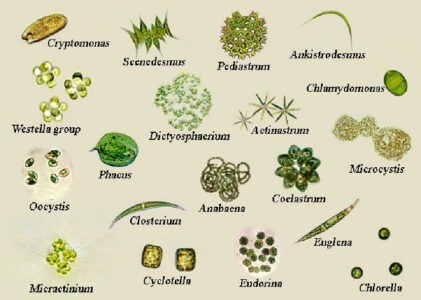
Image Showing Different Types of Phtoplankton Species
B) Zooplankton
These are animal plankton. The word zooplankton is derived from the Greek word zoon which means animal. These are small protozoans and metazoans (crustaceans and other animals) that feed on other plankton. Some of the larger animals include eggs and larvae such as fish, crustaceans and annelids.
Since the biological productivity of any aquatic habitat depends on planktonic organisms, it is vital to gain knowledge about them. Plankton are free-floating plants and animals that do not have the ability to move. Although mobility exists, it is so weak that it has to move based on currents and waves (Welch 1952).
Plankton are small animals that can float freely in lakes and sea water columns. Their distribution is mainly controlled by water flow and mixing action. The zooplankton community in most reservoirs is smaller than a few microns (Protozoa) to 2 mm (macrozuoplankton).
There are four main groups of freshwater zooplankton. These are the two subclasses of protozoa, rotifers, and crustaceans, cladoscerans and copepods. Little is known about the productivity of planktonic protozoans. In some cases, however, flagellates, rhizopods, and ciliated protozoans form components of the zooplankton community.
Rotifer is also a major component of zooplankton. According to Ali and Chakraborty (1992), there are 100 species of planktonic rotifers in the water bodies of Bangladesh. Because zooplactons are important food for fish and invertebrates, they act as a driving force in aquatic food nets. Zooplankton are dependent on algae, bacteria, protozoa and other invertebrates.
The important community in the aquatic ecosystem is the zooplankton. They are involved in the ultimate biological production. In the edible food chain of aquatic ecosystems, zooplankton play an important role in the transfer of energy from fish to primary producers.
They play an important role in the natural food chain by forming important food components of omnivorous and carnivorous fish. Carp larvae feed mainly on zooplankton (Berdach et al.1972; Dewan et al.1977). They feed on zooplankton to provide the protein needed for rapid growth and development of various organs, especially fish gonads.
TickiT Telescopic Pond Net
Fish production largely depends on zooplankton. Catla catla contains 48.6% of food content, Rui fish (Labeo rohita) contains 8.36% of food content (Ali and Islam 1981), Koi fish contains 72% of food content (Ali and Islam 1981), Galda icha (Macrobrachium rosenbergii) ( Shaofi and Quddus 1975) and Rohtee cotio 23% (Ali et al.1984) of zeoplankton. Zooplankton serves as an eater at the primary and secondary trophic levels of the food chain (Qassim 1977).
In most reservoirs, the density and species of zooplacton vary vertically and horizontally. Moreover, the density of zooplacton and the number of species vary in sampling at different times in these reservoirs. Seasonal changes in the life cycles of different populations result in drastic changes in the density and species of zooplankton.
2. Based on Size:
Plankton can be divided into the following groups based on size, viz.
(A) Megaplankton: more than 20 cm in size. Some metazoans such as jellyfish; ctenophores; salps and pyrosomes (Pelagic tunicata); Cephalopoda; Amphipoda etc.
(B) Macroplankton: They are up to 2-20 cm in size. Some metazoans such as Pteropods; Chaetognaths; Euphausiacea (krill); Medusae; ctenophores; salps, doliolids and pyrosomes (Pelagic tunicata); Cephalopoda; Janthinidae; Amphipoda etc.
(C) Mesoplankton: They are 0.2-20 mm in size. Is up to. Some metazoans such as copepods; Medusae; Cladocera; Ostracoda; Chaetognaths; Pteropods; Tunicata; Heteropoda etc.
(D) Microplankton: They are 20-200 µm in size. These are large actual cell protists, mostly phytoplankton, Protozoa, Foraminifera; tintinnids; ; Other ciliates; Rotifera; Juvenile metazoans, crustacea (copepod nauplii), etc.
(E) Nanoplankton: They are 2-20 µm in size. These are small real cell protists; Diatoms; Small flagellates; Pyrrophyta; Chrysophyta; Chlorophyta; Xanthophyta etc.
(F) Picoplankton: They are 0.2-2 µm in size. Small actual cell protists; bacteria; Chrysophyta etc.
(G) Femtoplankton: They are smaller than 0.2 µm in size. Such as marine viruses.
A symposium on the size of plankton was held in 1958 in Bergen, Norway. This symposium is divided into the following types of plankton based on the size of plankton:
| Plankton Type | Size |
| Megaloplankton | >1 cm |
| Macroplankton | 1 mm-1 cm |
| Mesoplankton | 0.5-1 mm |
| Microplankton | >60 μ |
| Nanoplankton [sic] | >5 μ |
| Ultraplankton | < 5 μ |
Moreover, Dussart proposed the following classification of plankton in 1985:
| Plankton Groups | Plankton Name | Size |
| Netplankton | Megaloplankton | >2000 micrometers |
| Mesoplankton | 200- 2000 micrometers | |
| Microplankton | 20- 200 micrometers | |
| Nanoplankton | Nanoplankton | 2-20 micrometers |
| Ultraplankton | < 2 micrometer |
In 1984, Omori and Ikeda proposed the following classification of plankton:
| Plankton Type | Size | Group |
| Megaloplankton | >20 millimeters | |
| Microplankton | 20-200 millimeters | Net Plankton |
| Macroplankton | 2- 20 millimeters | Net Plankton |
| Mesoplankton | 200 micrometers- 2 millimeters | Net Plankton |
| Microplankton | 20- 200 micrometers | Water bottle plankton |
| Nanoplankton | 2- 20 micrometers | Water bottle plankton |
| Ultraplankton | < 2 micrometers | Water bottle plankton |
Table: Zooplankton of excavated Harda Baor and non-excavated Chandbil Bill Baor in Meherpur district of Bangladesh, Kabir and Naser (2009). (Zooplankton Classification based on Gojdics 1953, Parker 1982 and Ward & Whipple 1959)
Reef Phytoplankton
Phylum: Protozoa
| Plankton Name | Plankton Name |
| Class: Euglenophyceae Order: Euglenales Family: Euglenaceae Genus: Euglena Ehrenberg Euglena acus Ehrenberg Euglena fusca (Klebs) Lemmermann Euglena clavata Skuja Euglena oxyuris Schmarda Euglena oxyuris var. minor Defl. Euglena geniculata Dujardin Euglena granulata (Klebs) Schmitz Euglena proxima Dangeard Euglena sanguinea Ehrenberg Euglena elastica Euglena gosdicsae Prescott Euglena spathirhyncha Skuja Euglena tripteris (Dujardin)Klebs Euglena mutabilis Schmitz Euglena mainxii Deflandre Euglena viridis Perty Euglenaallorgei Deflandre Euglena sp. Genus: Phacus Dujardin Phacus longicaudatus (Ehrenberg) Dujardin Phacus pleuronectus Miiller Phacus similis Christen
| Phacusacuminatus var. indica Phacus ranula Pochmann Phacushameli Phacusundulata Phacus sp. Family: Volvocidae Genus Volvox Linnaeus Volvox sp. Class: Dinophyceae Order: Peridiniales Family: Peridiniaceae Genus:Peridinium Ehrenberg Peridinium sp. Genus: Ceratium Schrank Ceratium hirundinella Schrank Class: Rhizopoda Order: Testacealobosa Family: Difflugidae Genus: Difflugia Leclerc Difflugia corone Wallich Difflugia sp. Order: Testaceafilosa Family: Euglephidae Genus: Euglepha Dujardin Euglepha sp. |
Phylum-Arthropoda
| Plankton Name | Plankton Name |
| Class: Crustacea Order : Copepoda Suborder: Calanoida Family: Diaptomidae Genus:Diaptomus Forbes Diaptomus gracilis Sars Diaptomus sp. Genus: Skistodiaptomus Light Skistodiaptomus pygmeus Forbes Genus:Neodiaptomus Kiefer Neodiaptomus sp. Suborder: Cyclopoida Family: Cyclopidae Genus:Cyclops Muller Cyclops sp. Genus: Ectocyclops Brady Ectocyclops sp. Genus: Microcyclops Muller Microcyclops varicans Lillijeborg Microcyclops rubellus Lillijeborg Microcyclops sp. Genus: Mesocyclops Sars Mesocyclops leukerti Claus Mesocyclops edax Forbes Mesocyclops sp. Genus:Macrocyclops Claus Macrocyclops sp. Genus:Orthocyclops Forbes Orthocyclops modestus Herrick Genus:Eucyclops Claus Eucyclops agilis Koch | Order: Cladocera Family: Chydoridae Genus:Alona Baird Alona sp. Genus:Chydorus Leach Cydorus sp. Family: Sididae Genus:Diaphanosoma Fischer Diaphanosoma brachyurum Lieven Diaphanosoma sp. Family: Daphnidae Genus:Moina Baird Moina brachiata Jurine Moina sp. Family: Macrothricidae Genus:Macrothrix Baird Macrothrix sp. Order: Ostracoda Family: Cypridae Genus:Cypris Muller Cypris sp. Suborder: Harpacticoida Family: Bryocamptidae Genus:Bryocamptus Chappuis Brycamptus sp. |
Phylum Rotifera
| Plankton Name | Plankton Name |
| Class: Bdelloidea Order: Bdelloida Family: Philodinidae Genus: Rotaria Scopoli Rotaria neptunia Ehrenberg Class: Monogononta Order: Ploima Family: Brachionidae Genus: Anuraeopsis Lauterborn Anuraeopsis fissa Gosse Genus: Brachionus Pallus Brachionus angularis Gosse Brachionus calyciflorus Pallus Brachionus calyciflorus var. dorcas Gosse Brachionus calyciflorus var. dorcus-spinosus Brachionus calyciflorus f. amphiceros Ehrenberg Brachionus calyciflorus f. borgerti Apstein Brachionus calyciflorus f. anuraeopsis Brehm. Brachionus caudatus Barrois & Daday Brachionus caudatus var. personatus Ahlstrom Brachionus forficula Wierzeski Brachionus forficula f. minor Virinkov Brachionus falcatus Zacharias Brachionus falcatus var. hammatus Brachionus plicatilis O.F. Muller Brachionus nilsoni Ahlstrom Brachionus bidentata Anderson Brachionus urceolaris Muller Brachionus bennini Leissling Brachionus rubens Ehrenberg Brachionus diversicornis Daday Brachionus quadridentatus Hermann Brachionus zahnisheri Ahlstrom Genus: Keratella Bory de St. Vincent Keratella vulga Ehrenberg Keratella cochlearis Gosse Genus: Notholca Gosse Notholca acuminata Ehrenberg Notholca sp. Genus: Platyias Herring Platyias patulus Muller Platyias quadricornis Ehrenberg Platyias polycanthus Genus: Epiphenes Ehrenberg Epiphenes sp. Genus: Diplois Gosse Diplois daviesiae Gosse Diplois sp. Family: Brachionidae Genus: Euchlanis Ehrenberg Euchlanis dilatata Ehrenberg Genus: Tripleuchlanis Myers Tripleuchlanis plicata Levander Genus: Colurella Bory de St. Vincent Colurella bicuspidata Ehrenberg Genus: Lepadella Bory de St. Vincent Lepadella sp. Genus: Mytilina Bory de St. Vincent Mytilina ventralis Ehrenberg Family: Asplanchnidae Asplanchna herricki de Guerne Asplanchna priodonta Gosse Asplanchna sp. | Family: Lecanidae Genus: Monostylla Ehrenberg Monostyllla closterocera Schmarda Monostylla quadridentata Ehrenberg Monostylla sp. Genus: Lecane Nitsch Lecane leontina Turner Lecane curvicornis Murray Lecane nodosai Hauer Lecane sp. Family: Trichoceridae Genus: Trichocerca Lamarck Trichocerca capucina Wierzeski Trichocerca porcellus Gosse Trichocerca cylindrica Imhof Trichocerca longiseta Ehrenberg Trichocerca similes Wierzejki Trichocerca braziliensis Murray Trichocerca rousseleti Voight Trichocerca sp. Family: Lindidae Genus: Lindia Dujardin Lindia sp. Family: Gastropidae Genus: Ascomorpha Perty Ascomorpha sp. Genus: Chromogaster Lauterborn Chromogaster ovalis Chromogaster sp. Family: Notommatidae Genus: Cephalodella Bory de St. Vincent Cephalodella incila Wulfert Cephalodella forficula Ehrenberg Family: Synchaetidae Genus: Polyarthra Ehrenberg Polyarthra vulgaris Carlin Polyarthra sp. Order: Flosculariaceae Family: Testudinellidae Genus: Filinia Bory de St. Vincent Filinia terminalis Plate Filinia longiseta Ehrenberg Filinia opoliensis Zacharias Filinia camaseclaMyers Genus: Pompholyx Gosse Pompholyx sulcata Gosse Genus: Horealla Donner Horealla brehmi Donner Family: Flosculariidae Genus: Fluscularia Fluscularia sp. Genus: BeauchampiellaRename Beauchampiella sp. Family: Hexarthridae Genus: Hexarthra Schmarda Hexarthra sp. Pedalia fennica Levander |
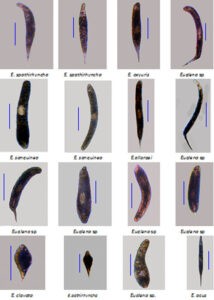
Diffreent types of Protozoan Zooplankton (Bar=50 μm, Photo: Dr N. Kabir)
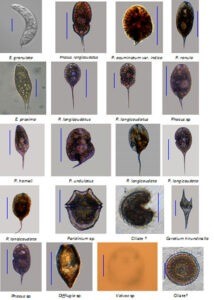
Diffreent types of Protozoan Zooplankton (Bar=50 μm, Photo: Dr N. Kabir)
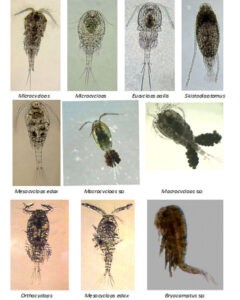
Image Showing Some plankton (Copepods Species): Photo-Dr N Kabir
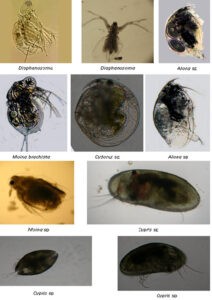
Image Showing Some Cladocerans Species: Photo-Dr N Kabir
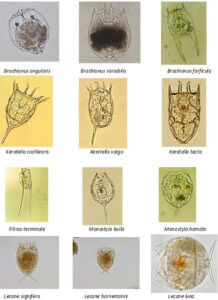
Image Showing Some Plankton( Rotifers Species): Photo-Dr N Kabir
3. Plankton Classification Based on Local Environmental Expansion
There are five types of plankton based on local environmental expansion, viz.
- Limnoplankton: These are the plankton of the lake.
- Rioplankton: These are plankton of running water.
- Helioplankton: These are the plankton of the pond.
- Helioplankton: These are salt water plankton.
- Hypalmyroplankton: These are the plankton of the estuary region.
4. Plankton can be divided into the following two types based on their origin, viz-
- Autogenic plankton: Plankton produced locally is called autogenic plankton.
- Allogeneic plankton: Plankton from other places is actually called allogeneic plankton.
5. Plankton can be divided into the following two groups on the basis of structural elements, viz.
- Euplankton: These are the real plankton.
- Pseudoplankton: If rotten matter is mixed with plankton, it is called pseudoplankton.
6. Plankton can be divided into the following two groups based on life history, viz-
- Holoplankton: They float for life.
- Metoplankton: They float freely at any stage of the life cycle.
